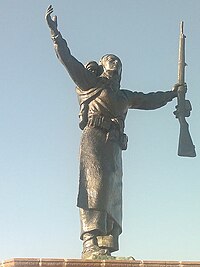Nene Hatun
| Nene Hatun | |
|---|---|

Statue of Nene Hatun by Metin Yurdanur at Aziziye Fort in Erzurum.
|
|
| Nickname(s) | Nene Hatun |
| Born | 1857 Erzurum, Ottoman Empire |
| Died | 1955 (aged 97–98) Erzurum, Turkey |
| Buried at | Aziziye Fort, Erzurum |
| Allegiance |
|
| Years of service | 1877–78 |
| Battles/wars | Russo-Turkish War (1877–78) |
Nene Hatun (1857 – 22 May 1955) was a Turkish folk heroine, who became known for fighting against Russian forces during the recapture of Fort Aziziye in Erzurum from Russian forces at the start of the Russo-Turkish War of 1877–1878.
According to Turkish folklore, she had been living in a neighborhood of Erzurum called Aziziye that was close to an important fortification defending the city. On the night of 7 November 1877, Fort Aziziye was captured by the Russian army on the evening of 9 November. Nene Hatun's brother Hasan, who was heavily wounded died that evening. In the morning when, the news of the Russian capture of Fort of Aziziye was heard, she kissed her dead brother's head and took an oath to avenge his death. She left her three-month-old baby girl and an adolescent son at home, joining the counterattack against Aziziye with her dead brother's rifle and her hatchet. The counter-attack was launched by Turkish civilians who were mostly women and elderly men armed with axes and farming equipment. Hundreds of Turkish civilians were killed by Russian gunfire but their numbers were so overwhelming they managed to enter the fortifications breaking down its iron doors. A hand-to-hand fight ended with around 2000 Russian soldiers being killed and rest ran away(see:Battle of Erzurum (1877)). Nene Hatun was found unconscious, wounded and her bloodied hands still firmly grasping her hatchet. She was identified as being the most heroic of them all and became a symbol of bravery.
Third-party reports on the battle for Fort Aziziye shed a less-favorable light on the events and speak of terrible mutilations being inflicted on the Russian soldiers. C. B. Norman, reporter for the Daily News, recorded that
Nearly every Russian found lying on the ground was decapitated or otherwise mangled; and the dreadful crimes appear to have been perpetrated by women from the city who, when it was seen that the Russians were defeated, issued forth with knives, hatchets, and other household weapons, to dispatch the wounded who lay gasping on the ground.
Nene Hatun lived the rest of her life in Aziziye. She lost her husband in the following years and her son Yusuf was killed in World War I during the battle of Gallipoli. After Turkish war of independence she had a difficult life, relying on help given by the local municipality, even sending a letter in 1943 to Turkish president Ismet Inonu asking for reinstatement of her one bread a day allowance. American General Ridgway visited her in 1952 and when he asked her if she could join a new war she told him "of course I will." In 1954 she was remembered as the last survivor of the Russo-Turkish War of 1877–1878 and was visited by General Baransel, commander of the 3rd Turkish army, and from then until her death she was known as the "Mother of the Third Army". She was named as "Mother of the Mothers" on the Mother's Day in 1955. She died of pneumonia on 22 May 1955 at the age of 98 and was laid to rest in the martyrs' cemetery at Fort Aziziye.
...
Wikipedia
